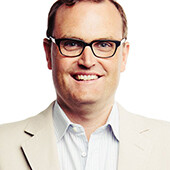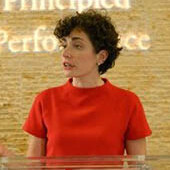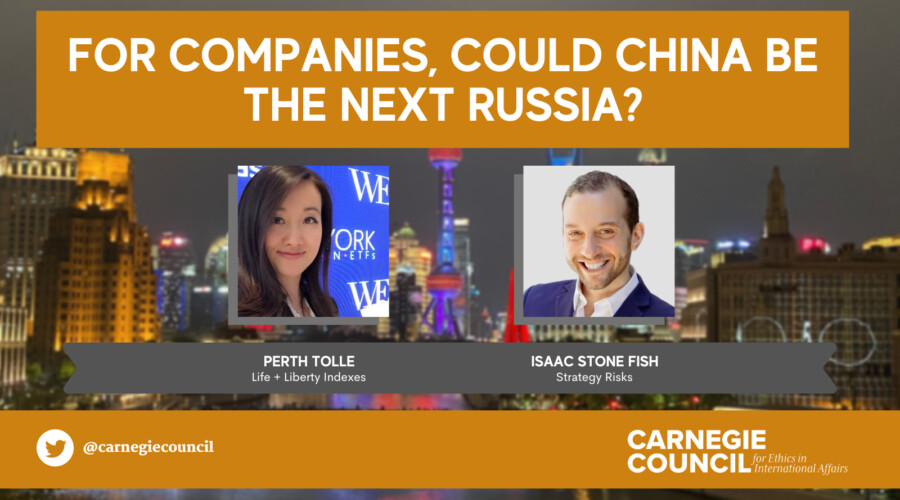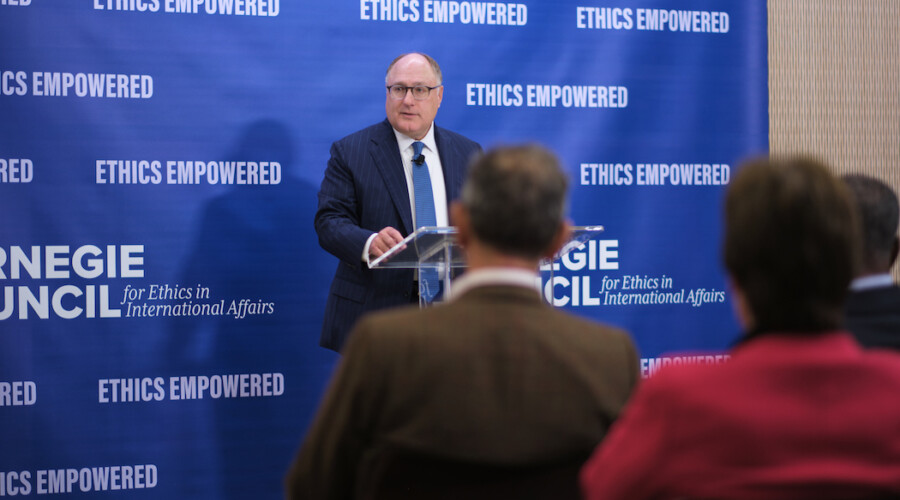Corporate leaders are increasingly aware that businesses can provide a positive (or negative) impact on the environment and community. But how can conscious companies prioritize social benefit while still pursuing profit? In part 2 of our series on conscious capitalism, we hear from Eileen Fisher, Patagonia, and other leading thinkers in the field.
This is the second episode of a three-part series on conscious capitalism. Click here for part one, "The Conscious Consumer."
JULIA TAYLOR KENNEDY: You're listening to Impact from the Carnegie Council. I'm Julia Taylor Kennedy.
In this episode, we're looking at conscious corporations. We've handpicked some corporate leaders who openly admit businesses often hurt the environment or treat workers unfairly and these leaders are actively trying to create better approaches. But even for conscious companies, a profit motive counterbalances a "do no harm" approach. After all, business exists to produce capital. So, becoming a "conscious company" is really tricky.
AMY HALL: One of the areas that, I would say, continues to dog all of us are working hours.
My name is Amy Hall. I'm the director of social consciousness at Eileen Fisher.
JULIA TAYLOR KENNEDY: Eileen Fisher was one of the first brands to ask its supplying factories to adhere to the Social Accountability 8000 international fair labor certification standards. It's a mouthful, but it's one of the most rigorous fair labor standards out there. Today, Eileen Fisher has somewhere between 20 and 30 apparel-producing factories, but only two of them have attained this certification.
Despite the pressure the company puts on its factories to adhere to these high standards, it sends mixed messages. For example, Hall says one of the trickiest times of year for Eileen Fisher's factories is the Chinese Lunar New Year.
AMY HALL: China is a big chunk of our manufacturing base.
JULIA TAYLOR KENNEDY: During Chinese New Year, the factories shut down for about a month.
AMY HALL: In order for us to plan for that, they need to manufacture maybe two months' worth of clothing in about a month. That pushes working hours very high, just in this particular time of year.
JULIA TAYLOR KENNEDY: Meanwhile, there is an ebb and flow in Eileen Fisher's production schedule as they prepare for the fall season or for other times of year when they need an infusion of products from their suppliers. And at those times, Eileen Fisher doesn't always consider its suppliers in its creative process of designing garments.
AMY HALL: What happens is, if we are designing a line, after we think the line is finished we may make a few more changes to the design but the delivery deadline of that line remains fixed. And so in order for the factory to be able to accommodate all those changes, it has to work overtime. So here we are, on one hand, asking them to restrict their working hours and on the other hand, pushing their workload higher.
JULIA TAYLOR KENNEDY: It's a conundrum: how can Eileen Fisher, as a brand, push for fair labor practices, while also maintaining creative freedom and meeting market demand? Hall has pulled together a cross-functional group of colleagues to grapple with these questions.
AMY HALL: The ideal solution is that we plan ahead so that factories have much more time to produce what they need to produce. It is not very practical, when you think about starting nearly a year in advance, when something enters the store, to design and develop a product. Stretching it out any more than that feels fairly impractical to most people who are in this conversation.
So we're looking at lean manufacturing. Given the current timeline, how can we make it a little easier and lighter for all involved? How can we eliminate so many changes, going back down to the supplier after they thought they had received the final version? How can we eliminate multiple reorders on a style that may be selling very well? What would that mean for our profitability? What would it mean for the stress level of our own people and the people in our supply chain? And we're looking at ways to quantify, where's the sweet spot in all of this?
JULIA TAYLOR KENNEDY: For right now, Hall has more questions than answers. But even asking those questions seems to take her ahead of other fashion brands.
AMY HALL: From the Eileen Fisher perspective, we do hope to be able to model that it's possible to be a profitable company in this day and age and base a business on a set of aspirational values that can actually be implemented in a real-life situation.
JULIA TAYLOR KENNEDY: Companies like Eileen Fisher are grappling with the tough questions of social consciousness internally—and how to turn that consciousness into better business behavior. Other companies are looking to build a brand around supporting social good.
GRANT GARRISON: For the past six years we have been helping companies, as well as non-profits and foundations, to engage their key audiences through impact programs. The common thread is how is the opportunity to do good a way for brands to connect with those they are seeking to engage.
Grant Garrison, managing director at GOODcorps.
JULIA TAYLOR KENNEDY: GOODcorps is the for-profit sister company of GOOD Magazine. The magazine's articles pop into many social media feeds to feature good behavior from celebrities, companies, and individuals. The consulting arm works with companies themselves to find ways to increase profits by aligning themselves with social causes.
GRANT GARRISON: What drives clients to us on the business side is a sense that consumers are looking for common values with the companies that they're supporting.
JULIA TAYLOR KENNEDY: Converting "common values" into profits can be hit or miss.
Garrison and I spoke a lot about Pepsi, which has been trying to rework its brand for several years. CEO Indra Nooyi has tried to move the company in a healthier direction, reducing the sugar and salt content of some of its products, and acquiring healthier brands like Tropicana and Quaker, while still keeping its core soda and Frito-Lay snack food brands. According to news coverage, Pepsi's journey to establishing a brand around "doing good" has been bumpy at best. Garrison recalls Pepsi's efforts to introduce a compostable bag for Sun Chips back in 2009.
GRANT GARRISON: The idea was that if you put this Sun Chips bag in your backyard compost bin in the right circumstances then the bag would compost. Thank you, PepsiCo, for doing that. Insiders in the world of CSR (corporate social responsibility) would say that's exactly what we're looking for from companies. Then the consumer testing said the consumers thought the bag was too loud and Sun Chips had to take it off the shelves because of that.
Companies are fearful, for good reason, of actually going beyond where their consumers are comfortable with them going in terms of sustainability or in terms of doing good.
JULIA TAYLOR KENNEDY: Around the same time, Pepsi became GOODcorps' first client. The company wanted to take the established approach to "cause marketing" a step further. For many years, companies have worked with various non-profits and foundations to raise money for causes they deemed worthy. Think of Susan G. Komen For The Cure—famously, the non-profit partnered with many large companies during Breast Cancer Awareness Month to funnel a certain percentage of their revenue or profits to breast cancer research. In 2010, Pepsi was interested in creating a new kind of cause marketing, and worked with GOOD to find a completely new approach.
GRANT GARRISON: We said, "Hey, if you guys take your $20 million that you'd spend on Super Bowl advertisements and instead give it away to communities and thousands of grants, you'll get as many eyeballs, as many impressions through that program as you would through the money you'd spend on the Super Bowl."
JULIA TAYLOR KENNEDY: So together they created a platform that borrowed its structure from crowdfunding startups like Kickstarter.
GRANT GARRISON: Meaning that anyone; non-profit, for-profit, or individual, could submit an idea to make the world or their community better and those that received the most votes as a form of community support would receive grants ranging anywhere from $250,000 down to $10,000.
JULIA TAYLOR KENNEDY: Six years ago, crowdfunding was a pretty new concept—so this approach was radical coming from such a big brand as Pepsi.
GRANT GARRISON: Fundamentally it was about —"We want to know what Americans care about and want to do in their communities and we will give this $20 million to the ideas that get the most support."
JULIA TAYLOR KENNEDY: Instead of dictating where the money would go, Pepsi asked consumers to help them decide. They called it the Pepsi Refresh Project. And from many perspectives, this project was a huge success.
GRANT GARRISON: The web traffic was unbelievable. We accepted a thousand applications a month. Huge amount of interest from that side.
JULIA TAYLOR KENNEDY: Pepsi and GOOD handed out more than 1,000 grants to community organizations and individual projects.
GRANT GARRISON: There was a guy who owned a tuxedo shop. He noticed that a lot of kids didn't go to prom because they couldn't afford a tuxedo. He just felt like, "I'd like to be able to give these kids tuxedos so that everyone can experience prom no matter how much money they have." He got $5,000 to help a bunch of kids be able to go to prom.
Those are the kinds of stories I guess, that everyday-American-heroes type of a feeling, that current philanthropy doesn't often throw its doors open to for some good reasons. I think Refresh was a unique asset to those types of community change-makers.
JULIA TAYLOR KENNEDY: Of course, helping individuals help their communities wasn't Pepsi Refresh's only goal. There was also a grassroots marketing campaign, which was hugely successful.
GRANT GARRISON: We also had over 4 billion earned media impressions. So, part of our job actually at GOOD was to work with each of these grantees to do community outreach, so to give them a press release template, send them a kind of event package with balloons and a coupon for some soda and pizza. That way they could throw a community event around their grant. We did capacity building for them to get on social media and begin to use social media to connect to their community.
So, to have that kind of traffic in a corporate website environment was highly successful.
JULIA TAYLOR KENNEDY: But . . . despite seeding so many community projects, and earning so much attention in the press and social media, Pepsi Refresh got huge criticism and was ultimately discontinued.
GRANT GARRISON: Most of the criticism of the Refresh project is that it did not drive sales, that in the first year of the program Diet Coke passed Pepsi as the number two beverage in the country. As a result Refresh is a failure.
JULIA TAYLOR KENNEDY: Remember—Pepsi funded its Refresh platform with its Super Bowl ad budget. And without that Super Bowl ad, the company's profits sank. Garrison finds all this criticism pretty unfair.
GRANT GARRISON: When Pepsi decided to do the Refresh project, it was an explicit guidance that this was not a sales-driving program. It was intended as a long-term brand building exercise, particularly for millennial consumers who were interested in brands doing something around their values, not just talking about it.
JULIA TAYLOR KENNEDY: Yet Garrison does approach clients in a new way today as a result of the Pepsi Refresh experience.
GRANT GARRISON: Even if the client says it's not about sales, you probably ought to consider it to be about sales.
JULIA TAYLOR KENNEDY: It was really costly to learn that lesson in such a high-profile way.
GRANT GARRISON: We're starting to see a kind of tough-eyed skepticism about the true value of doing good for the business. We see our job as digging into that and answering that for brands.
People are demanding more results. We enjoy that challenge, but it's a very real one.
JULIA TAYLOR KENNEDY: So GOODcorps did a deep examination of the Pepsi Refresh experience, to figure out other lessons going forward.
GRANT GARRISON: I think fundamentally if there was a mistake here it was the media contrast between the brand. Pepsi is historically about lightness, music, sex. Drinking a soda is not a serious endeavor. It's something you do when you want a light break in your day knowing that it might not even be the best thing for you. That's traditionally what the brand has been about.
For that brand to wade into the world of doing good was really innovative. But maybe not ideal for the entirety of their brand campaign because there were some contrasts between some of these ideas which were tear-jerkers or really moving and a brand that's really not fundamentally about that.
In my reflection, it may be that there was a strategic misalignment there that is worth remembering as we work with future clients and which we sought to adapt to in year two of the program by changing some elements of it.
JULIA TAYLOR KENNEDY: Today when working with clients, Garrison recommends companies choose causes more closely aligned with their brands. Dick's Sporting Goods, for example, built a platform to support school sports teams who needed a funding boost.
GRANT GARRISON: If you go back and watch their commercials for the past few years, it's a lot of really moving stuff about the power of sports for kids. Then building on that brand platform a campaign that activates that value in support of youth sports teams that don't have enough money to take the field is a natural extension. It's not a sub-brand. It's not a distraction. It's an expression of that brand in a new way.
JULIA TAYLOR KENNEDY: Still, this kind of cause marketing doesn't really relate directly to Dick's Sporting Goods' supply chain or to the way it produces its goods. The outdoor clothing and gear company Patagonia has long linked its production approach to its brand reputation. And that company is more comfortable connecting the two in external conversations.
JILL DUMAIN: We have the not only ability to work to environmental standards but the responsibility to because of how strongly our owners believe in that.
My name is Jill Dumain, and I'm the director of environmental strategy at Patagonia.
JULIA TAYLOR KENNEDY: Patagonia has long worked to be sustainable, but started finding contradictions in its environmental point of view around 1990.
JILL DUMAIN: At that time we already had a program giving money to non-profit groups, so we might have been paying for river cleanup in one place and not really paying attention to what we'd be doing in a river with our dyes and finishes from a specific mill in another part of the world. We really started to investigate and understand where we had opportunities to basically clean up our own house with what we were doing. We hired some consultants and got a report back in 1991 that was the beginning of what's come to be known today as a Hot Spot Analysis of where were the places that were really impacting the environment heavily that we might actually be able to do something about. One of those was cotton growing, and the amount of pesticides that were being used at that time in the fields was really alarming when we started to look at it.
And so, we teamed up with some non-profit organizations and some farmers who were just starting to grow organically and shifted in 1996 to sell only organically grown cotton in our products, and we've done that ever since for our cotton products.
JULIA TAYLOR KENNEDY: After doing a lot of internal work on its supply chain and carbon footprint, Patagonia started building its external brand around sustainability as well. Perhaps the height of this effort occurred with an ad campaign five years ago. Patagonia bought ad space in many major publications, including a full page in The New York Times on Black Friday telling potential customers, "Don't Buy This Jacket."
JILL DUMAIN: The goal of that was to get people to just sort of stop the madness of looking for percentages off the price point to see how much they could buy, and to stop and think about how many resources went into every new thing that they buy. And the fine print in that was talking about the impact of that jacket, and saying, "Pay attention to what you're buying," because it's not just this jacket, but there's a lot of stuff that sits behind it and trying to get people to stop and think, in the midst of the frenzy of shopping, moving towards the holiday season, to say "Do I need a new jacket this year?"
JULIA TAYLOR KENNEDY: There was a lot of hand-wringing around Patagonia's offices before the ad ran.
JILL DUMAIN: You can imagine, it was the full spectrum of people saying, "Yes, do it, do it, do it," and sales going, "What are you talking about? This is where we make our profit as well," as a for-profit company. So it's always a tension between the environmental and business operations. So out of this very healthy tension between those two ends of the spectrum pulling and making sure we're making good long-term decisions, I think it's actually a really healthy place for our company to be.
JULIA TAYLOR KENNEDY: They were even preparing for an uptick in sales of the same jacket they were telling customers not to buy.
JILL DUMAIN: Internally, it went from the guy in charge of inventory—he was sitting there and as we were putting the ad together one night, he said, "What jacket, what color? I want to make sure I have enough in stock." We're like "Manny, we're telling people not to buy this jacket." He says, "I know, but they're going to highlight this jacket in The New York Times. I need to be ready" to, "Are you sure? What's this going to do? Are we going to seem like a hypocrite because on the same token, we're selling stuff for the holidays to somebody," to others saying, "No, we really need to put this out there and get people to start to think about it." So with everybody knowing intuitively, I think, it was the right thing to figure out how to do it, and to take a chance and put it out there.
JULIA TAYLOR KENNEDY: This angst extended to exactly which words would go in the ad.
JILL DUMAIN: We were really careful on how we worded it, to come across with the authenticity that we really had in developing it.
And the result was, immediately, in running the ad, that the sales didn't really change from that ad, but it has prompted a lot of very, very good conversations for a long time now, of trying to grapple with this issue of consumption. You listen to the radio, you watch TV, you read the newspaper, go online and your social media is full of all these discounts, "Buy this, buy it before it's gone," and this urgency in shopping that we've all been trained to pay attention to today, this "don't buy the jacket" ad was meant to try to cut through some of that, and have a little bit of that surprise factor of it coming from a consumer goods product company.
JULIA TAYLOR KENNEDY: In some ways, Patagonia is lucky. Its core service is to provide gear and clothing to outdoorspeople, and so the company's reputation for environmentalism can be a bonus for its customers. As further proof of its commitment to social responsibility, Patagonia is a B Corp—that means it's been certified by an independent organization called B Lab for meeting certain requirements in its business practices.
ANDREW KASSOY: One of the core tenets that we hold to is that we need to be able to measure and manage impact with the same rigor that we do profits if we really want to know whether companies are doing something good for the world.
My name is Andrew Kassoy and I'm one of the cofounders of B Lab.
JULIA TAYLOR KENNEDY: B Lab's website lists companies that have passed a tough certification process. Patagonia is one. So is Eileen Fisher. So are more than 1,500 other businesses, including service providers and consumer goods companies. Kassoy quickly gets philosophical when he talks about the range of approaches he's encountered from the companies that belong to his B Lab community. When it comes to a company's motives for doing good, he is agnostic.
ANDREW KASSOY: The B Corp movement has got a pretty big tent. The end objective is to create a shared and durable prosperity, it's to create value for society, so whatever the best methodology to do that is, is what people should be pursuing.
There are businesses that are in sectors where they think they should intentionally take less profit in order to create more social value. They're making choices to make those trade-offs. And sometimes there are things that can be solved best by having a business that scales and is highly profitable and so that might be the best thing there.
JULIA TAYLOR KENNEDY: To maintain high standards, B Lab reviews each B Corp every two years to ensure the company is adhering to the certification requirements.
ANDREW KASSOY: We have a verification process and if a company has fallen below the line or done something to intentionally answer a question wrong to get more points then they get removed from the community. We're not here as an activist to play "gotcha" and so we don't start advertising that or trying to shame people. That's not our particular role in this movement. Our role is to shine a light on the leaders. But we have a process. So if an accusation is made that is material and credible then we investigate through our Standards Advisory Council and we have asked companies to leave the community.
JULIA TAYLOR KENNEDY: In addition, B Lab is working at the state level across the U.S. to create a new legal designation for B Corps. So far, 32 jurisdictions legally recognize B Corps.
ANDREW KASSOY: We can change people's intentions or their hopes; that's the culture shift part of this. But if we don't build the institutions, like the rule of law, to facilitate that change in culture then it won't be made permanent. If we're trying to create a shared and durable prosperity then we have to create laws that support business with a purpose for the long-term.
JULIA TAYLOR KENNEDY: We heard from journalist Michael Hobbes in our last episode about his article "The Myth of the Ethical Shopper" in Huffington Post. Hobbes agrees that institutions need to change to promote better business behavior. But he argues that need extends far beyond supporting conscious companies that are already eager to do good. Hobbes says public policy can wield a strong stick as well as a carrot. The EU, for example, passed a regulation about toxins in electronics and cell phones back in 2003.
MICHAEL HOBBES: So they passed this regulation, and they told all of the suppliers in places like Malaysia, they said, "Look, if we find this toxin in any cell phones that are getting imported into the EU, we're going to throw out the entire batch. We're going to check randomly every cell phone that comes into the EU. If we find one that has this toxin in it, the entire shipping crate gets sent back and you have to pay for it."
All of a sudden, every single company in Malaysia is responsible for their own supply chains, and this isn't theoretical. It's if there's a trace of this element, you are on the hook for it. And overnight, that product was out of every single cell phone that was sold in Europe, and it shows that if there is an incentive for companies to do it, they can do it. But right now, nobody's putting that responsibility onto these companies, and nobody's really using the power of the markets to say, "This is unacceptable to us, our consumers have declared that this is a value for them, and we're not going to accept these goods anymore." Nobody's done that.
JULIA TAYLOR KENNEDY: In other words, the policies used to ensure product safety could be used to ensure worker safety and human rights . . . but they rarely are being used for that.
MICHAEL HOBBES: I mean, most of the people I know who work in human rights, or CSR departments, in big companies, are really good, really hard-working people. But they're being asked to do these incredible tasks with like teams of three people in a company with 200,000. And a lot of it just comes down to really boring stuff like resource allocations, and budgets, and strategic priorities and policies.
And this kind of slow and unsexy sort of work—it's actually a lot more difficult to get child labor out of your supply chain than it sounds. It sounds like, "Oh, go in there and find everybody's birth certificate, and get them out of the factories." Well, people fake their birth certificates. And if you find somebody who is actually 16 working in your factory, well it turns out that there's no school for him in the city where he lives.
JULIA TAYLOR KENNEDY: That's where the public sector should come in, Hobbes says. Government can't just create policies so consumers know which businesses opt to meet a certain standard—he is arguing for regulatory restrictions so every business must meet a certain standard. And that'll trigger a need for educational infrastructure so that young laborers have alternatives to working in factories. And the list of societal needs goes on and on.
MICHAEL HOBBES: We need to be angry at the companies and we need to be angry at the government for allowing the companies to get away with this stuff. It's not about, "I need to buy a better t-shirt," it's about, "why isn't my congressman pushing the government to make sure that no bad t-shirts are sold in America?"
I live in Berlin. I cannot buy a light bulb that is not a fluorescent light bulb. That one policy change is a million times more effective than a million consumer campaigns saying, "Buy fluorescent, buy fluorescent, buy fluorescent." I can't buy a non-fluorescent light bulb if I wanted to.
We keep trying to influence people's choices, but we should be trying to influence their options.
Why am I able to buy a t-shirt with child labor in it? I shouldn't be able to buy that. That should just be the baseline, in the same way I'm not able to buy something that is going to poison me.
JULIA TAYLOR KENNEDY: In pointing out the limitations of both conscious consumers and conscious companies, Hobbes is making a bold call for more government oversight. But there's one actor in this drama we haven't yet met, and that will be the focus of our next episode: the conscious investor, who has also been on the rise.
Thanks for listening to Impact from the Carnegie Council. A special thanks to our production team, Amber Kiwan, Terence Hurley, Deborah Carroll, Alex Woodson, Matthew Sacco, and Tariq Kenney-Shawa.
I'm Julia Taylor Kennedy. You can find out more about this podcast at carnegiecouncil.org.
You can also find us on iTunes, or wherever you download your podcasts.






